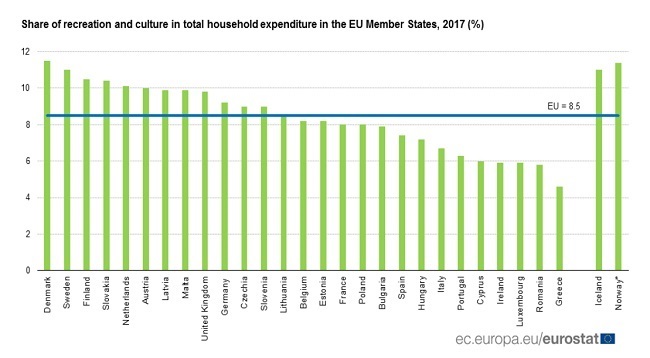Analytics, EU – Baltic States, Financial Services, Society, Statistics
International Internet Magazine. Baltic States news & analytics
Friday, 05.12.2025, 11:27
Latvian households spend 10% of income on culture and entertainment
 Print version
Print versionn 2017, households in the European Union (EU) spent 8.5% of their total consumption expenditure on "recreation and culture". This represents a total expenditure of over 710 bn EUR, equivalent to 4.6% of EU GDP or 1400 EUR per EU inhabitant. A more complete overview of household final consumption expenditure, broken down by consumption purpose
Denmark and Sweden spend highest share of household expenditure on recreation and culture
In the EU in 2017, the share of household expenditure devoted to “recreation and culture” was largest in Denmark (11.5%) and Sweden (11.0%) ahead of Finland (10.5%), Slovakia (10.4%), the Netherlands (10.1%) and Austria (10.0%). At the opposite end of the scale, Greece (4.6%) spent the lowest share of their household expenditure on “recreation and culture”, followed by Romania (5.8%), Ireland and Luxembourg (both 5.9%) as well as Cyprus (6.0%).

Share of expenditure on recreation and culture decreased mainly in Finland
Between 2007 and 2017, the share of "recreation and culture" in total household expenditure dropped in most Member States. In particular, the highest decrease over this 10-year time period was recorded in Finland (from 12.3% of total household expenditure in 2007 to 10.5% in 2017, or a decrease of 1.8 percentage points – pp) and Slovenia (-1.6 pp), ahead of Ireland (-1.3 pp) and Belgium (-1.2 pp). In contrast, the share of "recreation and culture" in total household expenditure increased between 2007 and 2017 in Slovakia (from 9.0% in 2007 to 10.4% in 2017, or a rise of 1.4 pp) and Lithuania (+1.3 pp), followed by Romania (+1.0 pp), Poland (+0.6 pp) as well as Bulgaria and Latvia (both +0.4 pp), while it remained stable in Austria.








 «The Baltic Course» Is Sold and Stays in Business!
«The Baltic Course» Is Sold and Stays in Business!

